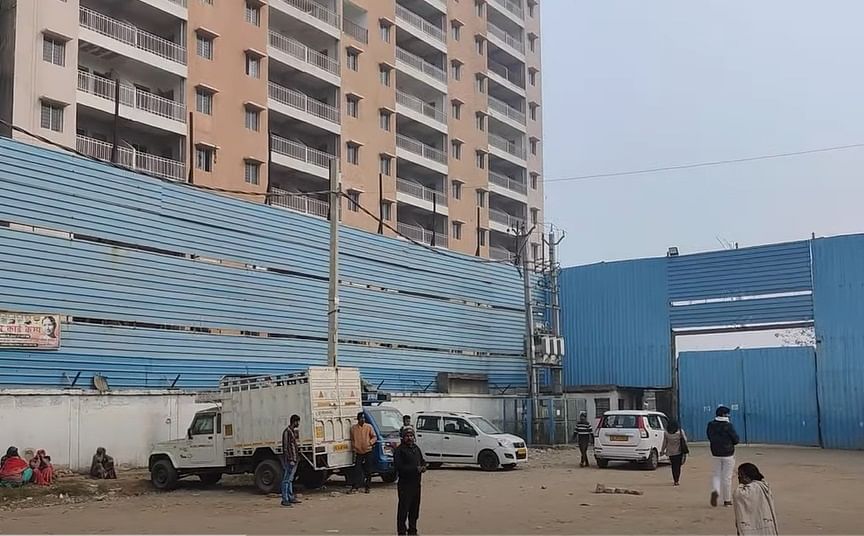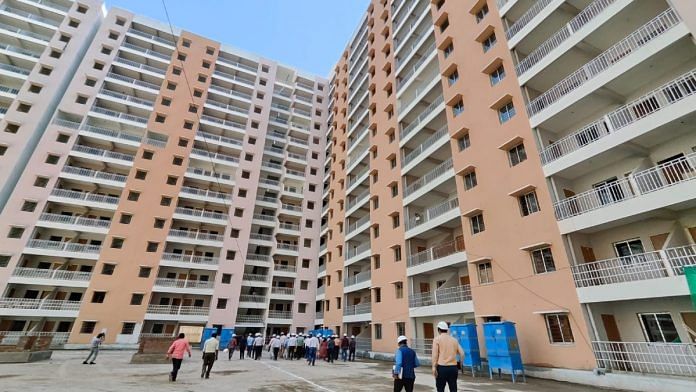New Delhi: In North Delhi’s Ashok Vihar, a 14-storeyed housing complex stands out as it towers over the surrounding Jailorwala Bagh slum cluster and vacant plots.
This complex, with 1,675 flats, is one of three slum redevelopment projects taken up by the Delhi Development Authority (DDA) to provide dignified and affordable living spaces to Economically Weaker Sections (EWS) over nearly two decades. The other two projects are at Kathputli Colony near Shadipur Depot and Kalkaji Extension.
The much-delayed Jailorwala Bagh in-situ (at the original location) slum redevelopment project, was first tendered in 2014, but construction began only in 2017. It was originally supposed to have been completed by 2021, but now, after having missed several deadlines, it is set to be ready next month.

“The construction work will be completed by February-end. We will then start giving possession to people. We have issued demand-cum-allotment letters to 1,078 people,” DDA vice-chairman Subhasish Panda told ThePrint.
This is only the second in-situ slum redevelopment project set to be completed by DDA after the inauguration of phase I of the Kalkaji Extension slum redevelopment project by Prime Minister Narendra Modi in November 2022, ahead of the Delhi municipal elections. At the Kathputli Colony project, construction has been ongoing since 2018.
‘Jahan jhuggi, wahan makan (making houses where the slum is)’ has been a recurring key poll promise of both the Bharatiya Janata Party (BJP) and Aam Aadmi Party (AAP) in Delhi, but action has been slow on ground.
In comparison, states such as Maharashtra, Gujarat and Karnataka have successfully implemented several in-situ slum redevelopment projects. In Mumbai, many slum rehabilitation projects have been implemented. Adani Realty in 2022 won the bid for a Rs 5,000 crore project to redevelop Dharavi, considered Asia’s largest slum.
The DDA — which comes under the Ministry of Housing and Urban Affairs and is the nodal agency for the redevelopment of slums clusters on central government land in Delhi — has prepared plans for 10 other in-situ slum redevelopment projects across the city to provide housing to over 20,000 families.
According to data provided by the housing ministry in Parliament, of the 4.3 lakh houses proposed, close to 2.96 lakh have been sanctioned since June 2015 under the In-Situ Slum Redevelopment (ISSR) component of the Pradhan Mantri Awas Yojana-Urban (PMAY-U), which aimed to provide housing for all in urban areas by 2022.
There are 675 listed slum clusters on government land in Delhi, of which 376 are on central government land that will be redeveloped by the DDA. The remaining are on land under the Delhi government, Railways and other government agencies.
The Delhi government has also planned an in-situ rehabilitation project at Princess Park in Karol Bagh, which is yet to be tendered, according to Bipin Rai, member of the Delhi government’s Delhi Urban Shelter Improvement Board (DUSIB).
Also Read: What’s the ‘Delhi model’ of slum rehabilitation & how it compares to other cities
A long wait for slum residents
At the facilitation centre in Jailorwala Bagh, which was set up last year, eligible families are getting their paperwork in order to take possession of their flats.
“It has been a long wait to get this flat. The building has been under construction for over six years now. But finally, we will be able to stay in our own house,” said Hariom Kumar, an e-rickshaw driver who lives in the Jailorwala Bagh slum cluster. He is one of the 1,078 beneficiaries who have been allotted flats in the newly developed complex.
Around 10 kilometres away is Kathputli Colony, where construction of DDA’s first PPP (public-private partnership) in-situ redevelopment project — first proposed in 2009 — is going on since 2018. But the 2,800-plus beneficiaries, who have been living in a transit camp in Anand Parbhat for over seven years, are clueless about when they will get possession.
According to DDA vice-chairman Panda quoted earlier, close to 700 flats are ready and another 700 will be completed by March. “The plan is to complete the project by June this year and then start the allotment process.”
Asked why the project was delayed, Navin Raheja, chairman of Raheja Developers, which was awarded the tender for this project in 2009, said, “The work got delayed as we were handed over a portion of the land in 2021. Now the flats are ready and the project is in the final stages of construction. We will complete the work by June-end. The only issue right now is that the BSES is yet to set up its sub-station here.”
For the hundreds of artists — including puppeteers, acrobats, storytellers and folk dancers — at Kathputli Colony, the past few years have been challenging as they have been living in a transit camp. Patasi (65), a Rajasthani folk artist, said, “There are so many people who have been living in the transit camp for almost a decade. We now just want to live in our own house for which we have paid almost Rs 1.5 lakh. We just want the prime minister to hand over the keys to us.”
At Kalkaji Extension, 8,461 flats were to be constructed for residents of three slum clusters (Jawahar Lal Camp, Navjeevan Camp and Bhoomiheen Camp) in a phased manner. The project was conceptualised in 2011 and the foundation stone was laid in 2013. While 3,024 flats have been constructed, the remaining flats will be built after the new policy is notified with the finalisation of the Delhi Master Plan-2041.
Of the 3,024 flats, 1,862 have so far been allotted to eligible beneficiaries of the Bhoomiheen Camp. “We have conducted surveys of the other camps and will be allotting the balance flats to eligible beneficiaries soon,” said a senior DDA official.
‘Master plan amendment will help implement more projects’
In 2021, the DDA had planned redevelopment of 10 slum clusters in Dilshad Garden, Shalimar Bagh, Rohini, Pooth Kalan, Haiderpur, Okhla Industrial area, Vasant Kunj etc. to provide housing to 22,000 families living in nearby slums. Despite amending its slum rehabilitation policy and tendering the projects twice, the DDA didn’t get a good response.
“Private developers are asking for viability gap funding to the tune of Rs 100-200 crore. It is not financially viable for DDA as we are already providing land for commercial development to private developers to recover the cost of the project,” said another senior DDA official, who did not wish to be named.
The land-owning agency now plans to take up these projects after the amendment in the master plan is notified.
Under the existing policy, for a plot of 2,000 sq. mts (the minimum plot size for the projects), the maximum remunerative component given to developers was 40 percent. The plan is to now increase it to 50 percent to help private developers recover the cost of the project, said a senior DDA official.
“There are other changes proposed in the master plan. Once the new MPD is notified, changes will be made in the slum rehabilitation policy. We will again prepare the Detailed Project Reports of these 10 projects as per the new norms,” this official added.
DDA officials are optimistic that the amendments proposed in the rehabilitation policy will help implementation of new projects. “The policy change has been proposed to make it more lucrative for developers so that more projects can be taken up on Public Private Partnership (PPP) basis. The policy changes will be notified in the new Master Plan of Delhi-2041.”
However, urban development experts say that there is a need to look beyond the PPP option to rehabilitate slum residents. Aravind Unni, a housing and urban poverty expert, said, “While slum redevelopment on PPP has seen some success in Mumbai and in some cities in Gujarat, it is clear that the PPP hasn’t worked in Delhi. There is a need to look at other options. Like in PMAY-Urban where there are multiple options for construction of houses, there should be other options to redevelop slums instead of just focusing on PPP.”
(Edited by Gitanjali Das)






